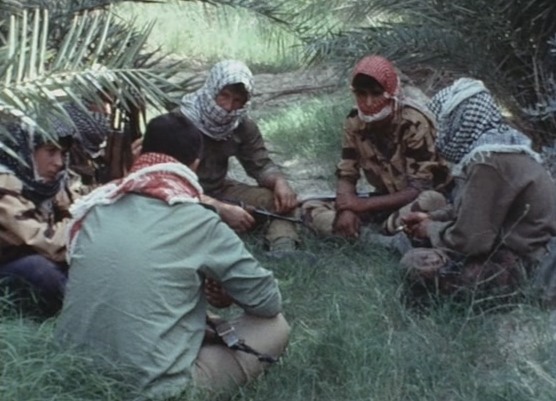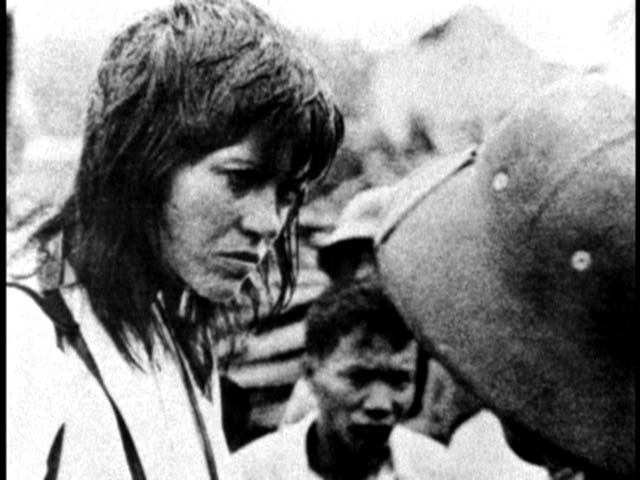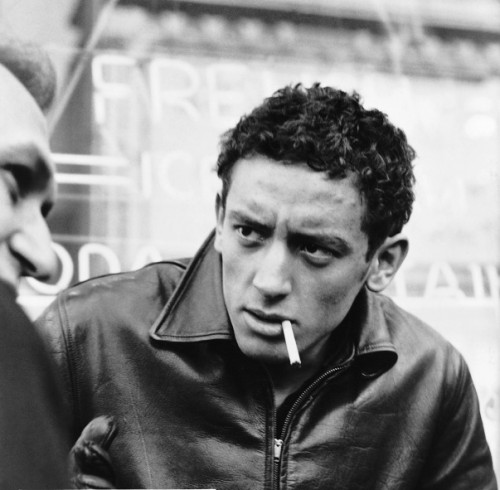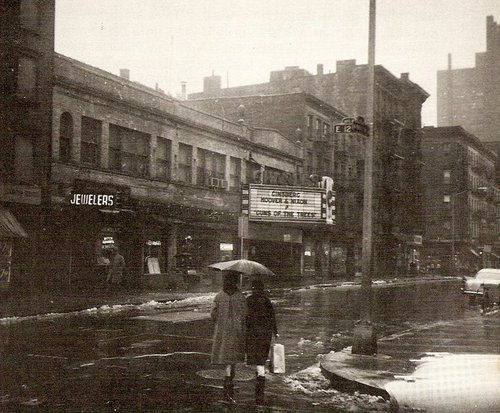From The Soho News (February 18, 1981). — J.R.
Ici et Ailleurs
A film by Jean-Luc Godard and Anne-Marie Miéville
Against the Grain
A film by Tim Burns
Radical Images
James Agee Room, Bleecker Street Cinema
Despite all the signs of exacerbated brilliance in Godard’s work since 1968, it is arguable that only after he left Paris in 1973 for Grenoble and Rolle — and before he made Every Man for Himself about a year ago — has he been able to function seriously as a political filmmaker, in direct and personal confrontation with his subjects.
Before that, preoccupations with the “correct” lines about certain struggles and their representations have cheifly yielded case studies for conservative armchair Marxists — ideal meditations for Parisian camp followers preferring to keep their feet dry and their politics fashionably academic. And from the vantage point of the next five years, it is difficult to avoid seeing Godard’s recent alliance with Coppola, at least partially, as a gesture of impotence and defeat.
The more purposeful stretch of his career that I have in mind begins with Ici et Ailleurs (Here and Elsewhere), in 1974, continues with Numéro Deux (1975), Comment ça va and Sur et sous la communication (both 1976) and ends with his difficulties in getting his second TV series France/tour/détour/deux/enfants broadcast as he intended in 1978 and 1979. It is precisely the work of this period — comprising about 3 1/2 hours of film and 16 hours of video — that has remained most inaccessible in the U.S. (Even the print of Ici et Ailleurs at the Bleecker is unsubtitled, meaning that viewers without fluent French have to depend on a printed version of the text in English.)
What makes Ici et Ailleurs important in a pivotal way is the fact that both of Godard’s major collaborators — the grandstanding Jean-Pierre Gorin and the deliberately invisible Anne-Marie Miéville worked on it at different stages over a four-year period. In 1970, Godard and Gorin traveled to Jordan, invited by the PLO, to film the Palestine revolution for Till Victory — a work-in-progress saluted on the opening cut of Patti Smith’s third album Easter but never completed. After Godard moved to Grenoble and set up his first Sonimage studio, he re-examined the Palestinian footage with Miéville (who has collaborated on every subsequent work of his); Ici et Ailleurs is the record of that encounter.
The “here” of the title is France — a working-class family watching TV, Godard and Miéville watching the Godard-Gorin footage and communicating offscreen. The “elsewhere” is not merely Palestine, but the film that Godard and Gorin wanted to make there in 1970. Like sound and image, now and then, or life and death, here and elsewhere essentially define one another dialectically, through a series of relays and exchanges — a process that for Godard and Miéville is indistinguishable from their responsibility to their subject.
What does it mean to be “responsible” to one’s subject? Something other than what Godard and Gorin are in Letter to Jane (1972), I would say, where their irritation with (envy of?)Jane Fonda ultimately bends their analysis into a form of glib self-flattery. Here, on the contrary, the injunction is, “Learn to see, not read.”
As Colin MacCabe points out, when “Godard went to Palestine to find images of the revolution that had never been seen in France, the sound (the political analysis, the practice of the Dziga-Vertov group) was too loud, so loud that it was impossible to see these images in relation to the quotidian images of France, so loud that it was impossible to see one’s own activity in the image, finally too loud even to see what was in the image itself.” Honestly, modestly, even beautifully, Ici et Ailleurs sets out to redress that imbalance, and it does so without vanity or masochism.
For one thing, most of the Palestinians filmed in 1970, training in refugee camps, died before Godard returned to the footage. Life, work, and the film itself proceed proceed remorselessly in their separate ways. Titles are situated within a musical arrangement of sounds and images like markers or place names set down on a multicolored road map: “Death in the film is represented by a flood of images…a flood of images and sounds that hide silence…a silence that becomes mortal because it is not allowed to emerge alive…. Maybe, in 1001 days, Scheherazade will tell this differently.”
It has taken Godard some time to learn ow to bear witness to brutal facts that are external to his fragmented sensibility. These facts are not readily exchangeable for media coverage, prizes, film festival slots or Hollywood contracts, and Godard has had to go elsewhere — with other goods and promises — to get those rewards. In Ici et Ailleurs, as in Numéro Deux (which is being promised a belated opening at Carnegie Hall Cinema this spring, in a subtitled version), the principal reward is irreducible clarity — and a human engagement that passes beyond the nihilism of Godard’s films with Gorin (as it does in Gorin’s own solo effort, Poto & Cabengo).
***
What happens when a filmmaker of little discernible imagination, craft, or talent (apart from a propensity to save and remember quotations) adopts some of the collage principles of Godard (who once said, “One must put everything into a film”)? Not so much to contend with for everyday moviegoers, who generally know enough to stay away; a bit more for hapless reviewers, who have to stay to the end so they can send back honest warning signals.
From the manufacturer of one time bomb to the explosion of another one inside a TV monitor 80 minutes later, Against the Grain follows the simple, hard-line aesthetic that a film equals X number of sounds plus Y number of images, shoved together indiscriminately and allowed to rattle about at will so that explosions, empty pockets of silence or dead space, or the intermittent drones of newscasters are made to seem equally haphazard and enlightening.
Most of the time, it’s like being stuck forever inside a badly acted version of a Huxley-style dialogue novel, peopled with leftwing terrorists and other Australian subversives who say bright, original things like “To photograph someone is a sublimated murder.” The terrorist hero’s mother offers a “revolutionary way” of making bread, and Randy Newman’s “Political Science,” mislabeled in the credits, gets played on the soundtrack for its Australian reference — and in order to tie up with the issue of whether Australia should mine its own uranium deposits and seek to become a major nuclear power; neither sequence gets articulated filmically, with any sense of pace or design. This is the first Australian underground feature I’ve seen, and it might deserve to go down in history as that country’s Guns of the Trees — for those who can still remember that early Jonas Mekas effort.








